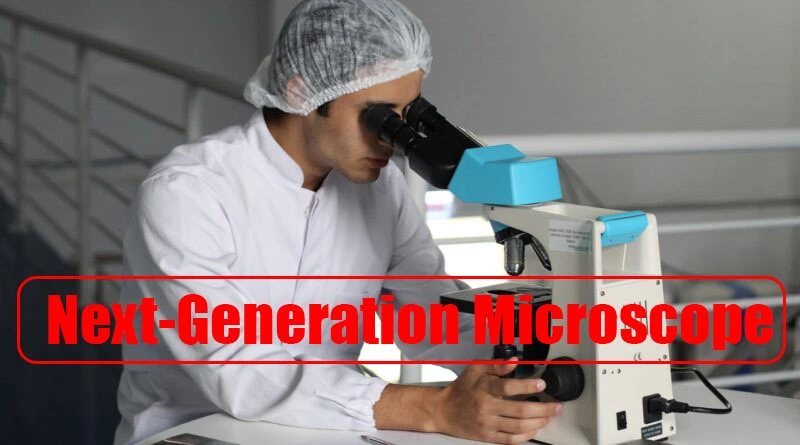A sample is typically pushed onto a pitcher slide to view living cells under a microscope. The cells can then be seen as it lies there evenly. The drawback is that it only provides one-dimensional images and limits how the cells can behave.
The next generation microscope has now been developed by scientists from the University Clinic of North Norway (unn) and the Arctic College of Norway. The new technology operates and lives in a more natural environment, allowing it to capture photographs of a far greater number of huge samples than before.
1-An excellent improvement:
The current generation offers 3-d images that allow researchers to view even the smallest pieces of information from various angles, clearly and transparently, separated into discrete layers, with all layers being aware of one another.
Although 3-D microscopes are already available, their performance is subpar. The most common version works by collecting pixels one at a time, which may then be put together to create a 3D image. This takes time, and frequently they are only able to process 1 to 5 photos each minute. If you imagine something that acts, it is not very feasible.
“With the help of our technology, we can alter about 100 entire frames in 2D. And we believe that expanding this range is definitely possible. Simply put, this is what our prototype has shown, according to researcher at uit Florian Ströhl.
The new microscope is a so-called multifocus microscope, which gives incredibly clear images, handled into distinct layers, allowing you to view the cells from all directions.
It is a big deal. This is a significant advance over the reality we used previously, adds Ströhl.
2-Able to look inside of gadgets:
Ströhl says that we are not talking about 3D in the way that most people think of it.
With the new technology, you can also see behind devices, but in a standard three-D image you can only discern a few types of depth.
Ströhl gives the example of watching a 3-D movie with a jungle scene.
In a typical three-dimensional image, you may tell that the forested region has depth and that certain leaves and pieces of timber are closer than others. You may even view the tiger hidden in the rear of the bushes using the same generation as in our new 3-d microscope. You may view and examine various strata on your own, claims ströhl.
A microscope is not used to look for tigers in the forest, but it is a vital tool for researchers when they are looking for answers in the smallest of details.
3-Investigating cardiac cells as they beat:
Ströhl has worked to advance this technique in conjunction with scientists and physicians from the University Sanatorium of North Norway (unn).
They work to identify various heart conditions and improve therapy options for them, among other things.
It is difficult to read a living human heart, both for technological and ethical reasons. As a result, scientists have employed stem cells that have undergone manipulation to resemble coronary heart cells.
By doing this, they can create natural tissue that functions just like it would in a human heart. They can then examine and test this tissue to learn more about what’s happening.
This tissue, which is roughly 1 cm in size, resembles a tiny piece of live meat. The fact that coronary heart cells are beating and moving regularly, together with the fact that the sample is too large to view under conventional microscopes, creates a very unsettling test scenario.
The updated microscope does this well.
“You need to take microscope photographs of this pulsing lump of flesh in a bowl. You need amazing high resolution and to be able to see the tiniest details of things. With the brand-new microscope, we were able to do this, said Ströhl.
4-Division System 1:
At the school of health at uit, Kenneth Bowitz Larsen is in charge of a sizable laboratory equipped with cutting-edge microscopes.
He put the new microscope to the test, and it passed.
“The idea is great, the microscope they built does things that the economic systems no longer accomplish,” says Larsen.
“Then, in addition, we work with research organisations like the one that Florian Ströhl represents. They build microscopes and evaluate optical standards; in some ways, they resemble the method 1 division of microscopy, explains Larsen.
Larsen has a strong belief in the brand-new microscope that Ströhl has developed.
While the microscope ströhl has developed is more specifically fitted to a particular task, industrial microscopes must be usable for all types of potential samples.
He oversees a laboratory that uses industrial microscopes from companies like Zeiss, Nikon, and many more.
It is extremely photosensitive and capable of showing the specimen in different focal points. You could see both the extreme and infrequent occurrences as it progresses through the pattern. And it occurs so quickly that it may almost be seen in real time.
It is a really quick microscope, explains Larsen.
According to Larsen, tests to date indicate that this works well, and he thinks that eventually, this kind of microscope can be used on all other types of samples where you look at living things that flow.
He also notices every other benefit that this microscope has to offer.
“Cells don’t like bright lighting fixtures very much. This microscope is so quick that the cells are exposed to much shorter illumination, which makes it more mild, he explains.
5-The period has a patent:
The microscope’s prototype is functional and in use. To enable more people to operate and use the microscope, the researchers are presently developing an improved version that is simpler to use.
In an effort to make this available for purchase, the researchers have also filed for a patent and are looking for commercial partners who will expand this into a microscope.
If anyone else in Norway has particularly troubling samples that they require evaluated, “we will also offer it to them,” says ströhl
